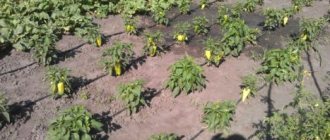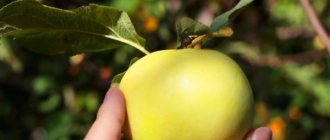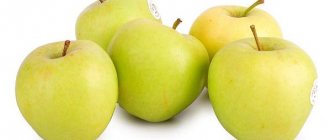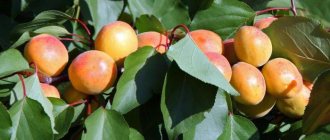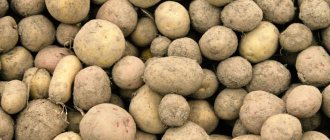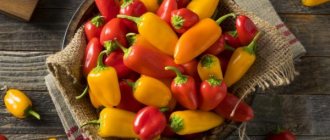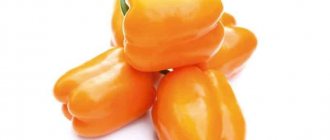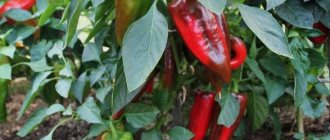Loading…
Loading…
The hot Habanero pepper, also known as Capsicum sinensis, is native to South America. That's why it turned out that way. that the Austrian scientist Nikolaus Jacquin, who described it, mistakenly assumed its origin. The fruits of this capsicum have such a hot taste that it is recognized as the hottest of all in the culture. Its natural habitat includes Brazil, Mexico, Colombia and the Caribbean, but it is cultivated in many regions of the world with suitable climatic conditions.
Description of hot habanero pepper
The height of the Habanero bush depends on its variety; the plant reaches a height of 50 to 150 cm. The fruits are small, heart-shaped, the weight of each peppercorn is 15-50 g. The color of the fruits is varied - at first they are green, then they become light or dark yellow. There are peppercorns in white and pink colors. The leaves are small, deep green in color with a glossy surface.
Description of the flowers of the plant - they are painted white, cream, purple color is less common.
Additional Information! The hot Habanero pepper has a very attractive appearance, thanks to which it is often planted in homes and gardens for decorative purposes.
Reviews
We bring to your attention several reviews from experienced summer residents.
Vita, Costa Rica: “For me, hot peppers have always been just hot. Until I found myself on the continent, where many of its species are home, and in traditional food you can’t do without it. First I tried sauces and pickled peppers. The most popular in Costa Rica are Jalapeños and Habaneros. Now I cook it myself all the time. One of the hottest in the world, but I love it!”
Svetlana, Liski: “I really like spicy dishes. I grow a lot of hot peppers, but my favorite variety is the yellow Habanero. The fruits have incredible taste! Imagine sweet hot peppers with a hint of melon! This will be the Habanero. I plant it in a greenhouse in the summer, in the winter I place it in a large pot and bring it into the house. All year round I have a fiery addition to my favorite dishes.”
Alisa, Ermolino: “I have experience in growing vegetable crops in garden beds, so I decided to try growing hot peppers on the balcony. I chose Habanero. The fruits are distinguished by their pungency, pronounced peppery taste and aroma. What I liked: unpretentious cultivation, high yield, long fruiting. I collected more than 80 peppers from one bush.”
History of vegetable breeding
The history of the Habanero pepper goes back over 8,000 years. It grows naturally in Mexico, Brazil and the Caribbean islands. Breeding of the vegetable began in the 1700s, when its seeds were spread by the Spanish through trade routes around the world.
Today, breeding work to develop new varieties of Habanero is taking place all over the world.
The name Habanero means “from Havanna,” the capital of Cuba.
Each variety of Habanero has its own use, since the taste characteristics of the fruit are different.
Benefits of pepper
By growing Habanero peppers in your garden or at home, you get spicy and tasty fruits. This pepper is an important ingredient in cooking. The fruits here can be used as components of sauces and various preserves. But Habanero is also used as a seasoning. With its help, cooks improve the taste of fish and meat, as well as many soups.
Being a component of many dishes, this plant, even with a slight presence in food, acts as an appetite stimulant. At the same time, do not forget that this pepper has a rich composition. Therefore, it is often included in traditional medicine tinctures.
Among other things, this plant is valued for its excellent decorative appearance. The bushes will look great both in the garden around the perimeter of the flower beds and at home on the windowsill (both in the kitchen and in other rooms). At the same time, this crop can be grown without any problems in any conditions.
As you can see, Habanero is an interesting vegetable crop. This plant is perfect for gourmets and “spicier” lovers, as well as for those who prefer to be treated with folk remedies. This variety will be a real find for home garden lovers. The main condition for success here is simply compliance with the minimum rules of care.
Best Habanero Varieties
Habanero has 18 varieties, each of which has fruits that differ in color and degree of bitterness. Application may also vary.
- Habanero Red Caribbean
The height of the bush is about 1 m. This variety is distinguished by its very high yield. It is grown in open ground, in greenhouses, and at home. Technical ripeness occurs in 90 to 100 days. The shape of the peppercorns resembles lanterns. The fruits are fleshy, with a dense peel, light burgundy in color.
Additional Information! The degree of bitterness in fruits depends on the amount of capsaicin in them.
- Habanero Red Savina
This species was bred in California. A distinctive feature is the greatest juiciness of the fruits among other types and the highest bitterness.
- Habanero Fatal
It was developed in South Africa. The color of the fruit can be brown or chocolate.
- Habanero Tigerpaw-nr
The color of the peppercorns is dark yellow, the degree of bitterness is medium.
- Habanero Orange
The fruits are bright orange, with wrinkled skin, no more than 4 cm in length.
- Habanero White
This variety of Habanero is the mildest in taste. The fruits are white.
Habanero White has the most atypical fruit color
- Habanero Chocolate
The name chocolate comes from the fact that the peppers are the color of chocolate. The peculiarity of the vegetable is its smoky aftertaste.
Capsaicin, which is present in varying concentrations in the pulp of peppercorns, is a substance that is not able to dissolve in water.
Attention! If after eating Habanero there is a strong burning sensation in your mouth, you will not be able to relieve this feeling by drinking a glass of water.
Collection and use of fruits
The indoor Mexican pepper is a perennial plant that bears fruit all year round. In open ground it is an annual plant. But it still produces a rich harvest. Fresh pods can be stored in the refrigerator for up to 10 days, while canned pods can be stored for 4 months.
Important! You should wear gloves when picking fruits from the bush, since the bitterness is difficult to wash off with water. And if the harvest is large, you need to wear a protective mask, because the pods evaporate toxic fumes that irritate the mucous membranes of the nose and eyes.
Gourmets recognize in these peppers not only incredible heat, but also a pleasant aftertaste and fruity-citrus aroma. Typically, the hot spice is used in recipes for meat, vegetable and fruit dishes. Dried pods add a spicy kick to drinks: martinis, tequila, hot chocolate. Habanero is also the main ingredient in spicy Mexican sauces, Tabasco and salsas. But you should not fry the pepper in boiling oil, because this will cause it to darken and lose its characteristic taste.
The hot Mexican Habanero pepper is easy to grow at home if you follow the correct agricultural practices. It will decorate any garden bed and windowsill, and will also add a unique taste to various dishes.
Characteristics of Habanero
Habanero is a unique vegetable. On the Scoville scale, it scores about 475,000 units, which is higher than even the most bitter varieties of chili.
Habanero is not only a delicious spice for vegetable and meat dishes. It contains many vitamins, macro- and microelements, which makes it very useful and, in addition to cooking, allows the fruits to be used in medicine and cosmetology.
A small peppercorn is a klondike of nutrients
Useful properties of the vegetable
The composition of Habanero is represented by vitamins B, C and D. Iodine, iron and calcium, copper, alkaloids and retinol are present in the pulp.
Regular consumption of hot chocolate habanero peppers and other varieties has a number of positive effects on the body:
- cleansing the body of toxins and waste;
- improving the functioning of the gastrointestinal tract;
- improvement of psycho-emotional state, relief of depressive states;
- lowering blood pressure;
- treatment of colds and viral diseases;
- slowing down age-related changes in the body;
- acceleration of metabolism;
- increasing the body's resistance to stress.
Additional Information! The vegetable’s ability to remove toxic substances and cleanse the body of toxins, as well as speed up metabolism, makes it a very useful product for those who are on a diet to lose excess weight.
Application
Habanero is used in various fields:
- Cooking - it is consumed fresh and dried. It is used as a spicy spice for a wide variety of dishes - vegetable and meat, for salads and soups; pepper is well suited for fish.
- Medicine - capsaicin, contained in the pulp of the vegetable, is used as one of the ingredients in lotions and creams intended to relieve pain caused by diseases of the musculoskeletal system.
- Cosmetology - capsaicin is included in drugs used to eliminate cellulite. It is useful to add a few drops of Habanero juice to your shampoo to restore the condition and functioning of the hair follicles.
Habanero is a key ingredient in the famous Tabasco sauce.
Advantages and Disadvantages of Habanero
Growing Habanero peppers at home is not a difficult process, since its agricultural techniques are not much different from other types of vegetables. Hot pepper has a number of advantages that have made it popular, but it is also not without its disadvantages, and a gardener who decides to grow a habanero should be aware of them.
Advantages:
- highest degree of bitterness;
- Widely used in cooking - Habanero will add a spicy, unusual taste to any dish;
- a large amount of harvest that can be harvested from one bush;
- presence of decorative characteristics;
- ease of cultivation and care.
Flaws:
- the vegetable is picky about the planting site and conditions - it loves a lot of light and warmth;
- susceptibility to nematodes.
Attention! Due to the incredibly strong bitterness, when picking the fruits, you must wear gloves and avoid touching your face and other areas of the skin and mucous membranes with your hands, otherwise severe irritation may occur.
Advantages and disadvantages of the variety
The main benefits of Habanero are:
- incredibly high degree of pungency, so the variety is widely used in cooking;
- simple cultivation;
- decorative appearance;
- high yield.
The disadvantages of this variety are:
- strong thermophilicity and even slight frosts can destroy the bush;
- low resistance to nematodes;
- strong bitterness - it is better to collect fruits with gloves.
You can watch a video review of the Habanero pepper variety in the following video:
Features of reproduction and cultivation
Habanero can be propagated by seed. Seed material is purchased ready-made or collected independently.
When to reproduce - timing
Habanero seedlings are prepared in February. Shoots appear in about 2 weeks - 1 month.
Preparing the container and soil
The soil mixture should be slightly acidic, no more than 6.5 pH units. You can prepare the soil yourself from the following ingredients:
- peat - 1 part;
- land - 2 parts;
- humus - 1 part.
It is recommended to plant seed in peat cups - this is the most suitable container. You can use a common box, but then the grains will need to be buried in the ground at a distance from each other, and when the seedlings grow, pick them.
Origin and description of the plant
The variety comes from South America. Breeders have improved one of the varieties of chili, reaching a heat of 300 thousand units on the Scoville scale. The pepper is approximately 40 times hotter than the Jalapeño.
The bushes are powerful, approximately 90 centimeters high. Hand protection must be used when harvesting. Fruit length is 25-30, width is 35-40 millimeters. The pods are wrinkled, have thin walls, and resemble acorns. As they ripen, the pods change color from green to yellow. They can be used to cook Jamaican and Indian dishes.
The following varieties are distinguished:
- White - white pods that look like chewing candy.
- Fatali - pungency is 125-325 thousand units.
- Tigerpow - orange pods.
- Red Caribbean - bright red pods. Commonly used to prepare Mexican dishes.
- Red Savina - fleshy pods.
- Chocolate – brown pods, slightly smoky and smelling of flowers.
Habanero contains a huge amount of vitamins and microelements. Each fruit contains iodine, iron, calcium and phosphorus elements, vitamins A, B, C, D. You need to be careful when using pepper for medicinal purposes. You need to familiarize yourself with the contraindications and determine the correct dosage.
Appearance of the bush
The stem of the bush is branched, the leaves are shaped like an egg. The pods look like a small heart and weigh about 50 grams.
Flowering and crop yield
It is possible to obtain up to 2.5 kilograms of pods from each plant. Up to 95 pods can ripen on one bush. During flowering, the bush emits a rather pleasant aroma.
Where are the fruits used?
Habanero is mainly used for preparing spicy dishes. Just add a little pepper and the dish takes on a very piquant taste. The fruits contain capsaicin, which promotes hair growth. You can add a drop of juice to your hair mask.
The pods are also used to make plasters; they serve as a kind of anesthetic. Pepper is also used to make anti-frostbite remedies.
Features of growing Habanero peppers at home
It is easy to grow Habanero at home - seedlings are prepared, and when the seedlings have 3-4 leaves, they are planted in separate pots. In a room, Habanero will grow for about 6-7 years; with proper care, the harvest can be harvested up to 2-3 times a year.
Attention! At home, Habanero needs warmth and long daylight hours - at least 16 hours. In summer it should be placed on the south side, and in winter it should be illuminated with phytolamps.
Landing
Seeds are planted for seedlings in February, or 2-2.5 months before transplanting to a permanent place. To grow at home, you can sow directly into a pot.
Pepper suffers when picking seedlings and may be stunted in development. To avoid this, it is better, if possible, to sow the seeds directly into separate peat cups.
Before sowing, the seeds are warmed up and simultaneously disinfected by placing them in a warm solution of potassium permanganate (about +40 degrees). After half an hour, they are rinsed and treated with a stimulant “Zircon”, “Epin” or similar.
Sow at a shallow depth, moisten well and place in heat. After germination, the temperature should be +18-25 degrees. Seedlings need to receive good lighting at least 12 hours a day.
In the phase of the first full-fledged leaves, the bushes dive.
Planting and care in open ground
Seed material can be immediately lowered into open soil, but seedlings are preferable, since they are easier to care for, and it is possible to select the strongest seedlings.
Landing dates
Planting in open ground is carried out when there is no risk of a return of night frosts, and when the ground warms up. Depending on the climatic characteristics of the region, this may be in April - May.
Choosing a planting site, preparing the soil
Well-lit places are suitable, but the light should be diffused. There should be no drafts or strong wind. Before planting, the soil is cleared of weeds, fertilized and loosened.
Transplanting seedlings into open ground
Transplanting seedlings is carried out using the transshipment method - you need to leave a lump of old soil on the roots of the seedlings.
Watering and fertilizing
Habanero likes to be watered abundantly, but not frequently, up to 2 times a week.
Attention! If the bush grows at home or in a greenhouse, it needs to be moistened daily.
Applying fertilizers - the first feeding is 2 weeks after transplantation; the second time, fertilizers should be applied when the ovaries appear. For Habanero, complex mineral supplements or organics are used.
Bush formation
To give the Habanero bush a decorative appearance, it is recommended to pinch the top. Side branches are pruned to give the plant the desired shape.
Habanero can act as a beautiful houseplant
Productivity
From one bush you can collect from 70 to 100 peppercorns, depending on the type of vegetable.
Preferences of the “sultry Mexican”
Habanero is a perennial plant. If you create optimal conditions, it will delight you with fruits for several years.
Each bush usually produces up to a thousand peppers. You can grow it in winter - in a heated greenhouse or on a balcony - the pepper will continue to bear fruit.
He is very thermophilic , feels good in the bright sun, but does not tolerate drafts.
The most suitable soil is slightly acidic .
In most regions of our country, a “Mexican” is better off in greenhouses than in an open garden. It needs to be watered regularly, but not too much, otherwise the fruits will lose their exquisite aroma.
Any of the habanero varieties are grown from seeds purchased in specialized stores or ordered through the World Wide Web.
Important! Seeds must be in special packaging that protects them from moisture and other destructive factors.
Diseases and pests
Habanero has a strong immune system, so with proper care, diseases do not occur. Due to excessive watering, fungal diseases can develop - fusarium or blackleg.
Insects - aphids, whiteflies, spider mites. To combat them, a soap solution or insecticides are used.
Habanero is valued all over the world for adding piquancy to dishes and helping to better reveal their flavor. In addition, this vegetable is very healthy. It is not difficult to grow it, both at home and in the garden; even a novice gardener can cope with this task.
Beneficial properties of pepper
Habanero peppers attract culinary experts not only with their spiciness, but also with their beneficial properties - the list of positive qualities is very impressive. Let's take a closer look?
- Helps fight excess weight;
- Improves metabolism;
- Reduces blood cholesterol levels;
- Normalizes blood pressure;
- Reverses premature aging;
- Helps fight free radicals;
- Serves to prevent diabetes mellitus;
- Removes excess toxins;
- It is an anti-inflammatory and analgesic agent;
- Cleanses the intestines of harmful bacteria;
- Helps with colds and respiratory diseases.
Contraindications
Unfortunately, not a single product is without contraindications - this type of pepper also has them. It is recommended to avoid use in the following cases:
- Tendency to allergies;
- Gastrointestinal diseases;
- Sensitive or irritated skin.
Under no circumstances should untreated peppers come into direct contact with your skin or mucous membranes - you risk getting burned! Removing the seeds and pulp will help reduce the pungency.
Sowing seeds
Pepper cultivation begins with sowing seeds.
Step-by-step sowing of seeds:
- Sow the seeds in February. Wrap them in a damp cloth. Place in a warm place. Warmth is the key point; if it is not there, the seeds will not germinate at all.
- Make sure that the moisture does not dry out. Wait 3 days.
- To plant seeds, prepare peat pots with sterilized soil from 1 part peat, 2 parts soil, 1 part vermiculite, 1 part humus. The soil temperature should be about 26 °C. The soil should be slightly acidic with a pH of 6.5. Instead, you can purchase "Universal" soil from Morris Green.
- When, after 3–4 days, the seeds swell and begin to germinate, plant them, deepening them 0.7 cm into the soil. Water the soil before planting. Cover with clear glass or polyethylene.
- Constantly slightly moisten the soil with a spray bottle so as not to wash away the seeds.
- After 2 - 4 weeks the first shoots will appear, then remove the glass or film.
- Young sprouts can be illuminated with fluorescent lamps. Place the lamps at a distance of 10 cm from the seedlings. It is better if the peppers have 16 hours of daylight.
- When 2 true leaves grow, pick up the seedlings. You can transplant it into plastic cups. Further cultivation of seedlings consists of reducing daylight hours to 12 hours, placing the lamp 50 cm away from the seedlings.
- Remember to water the seedlings, but do not overwater them.
- When watering, you can add root or some complex fertilizers to the water: “Ideal”, “Florist Rost”.
- 2 weeks before transplanting, harden the seedlings, take them out onto the loggia for 1 - 2 hours, gradually extending the period the plants stay outside.
8 to 10 weeks after sowing the seeds, when the seedlings are 15 cm tall, continue growing by transplanting each seedling into a large pot. Place the pots on the windowsill. If you want to transplant peppers to a plot or greenhouse, remember that the air temperature should be +21 °C during the day, and from 12 °C at night.
